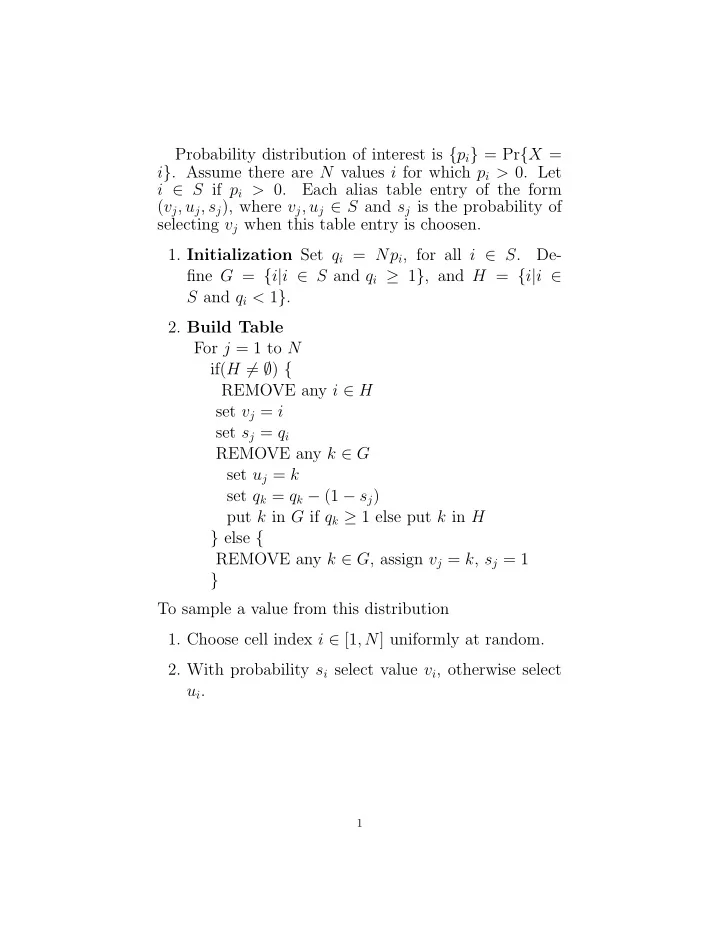

Probability distribution of interest is { p i } = Pr { X = i } . Assume there are N values i for which p i > 0. Let i ∈ S if p i > 0. Each alias table entry of the form ( v j , u j , s j ), where v j , u j ∈ S and s j is the probability of selecting v j when this table entry is choosen. 1. Initialization Set q i = Np i , for all i ∈ S . De- fine G = { i | i ∈ S and q i ≥ 1 } , and H = { i | i ∈ S and q i < 1 } . 2. Build Table For j = 1 to N if( H � = ∅ ) { REMOVE any i ∈ H set v j = i set s j = q i REMOVE any k ∈ G set u j = k set q k = q k − (1 − s j ) put k in G if q k ≥ 1 else put k in H } else { REMOVE any k ∈ G , assign v j = k , s j = 1 } To sample a value from this distribution 1. Choose cell index i ∈ [1 , N ] uniformly at random. 2. With probability s i select value v i , otherwise select u i . 1
Example : p 2 = 0 . 4 , p 6 = 0 . 1 , p 8 = 0 . 2 , p 9 = 0 . 3. The table below illustrates the state of the algorithm after each step. The initial state is value probability q Set index v u s 2 0.4 1.6 G 0 - - - 6 0.1 0.4 H 1 - - - 8 0.2 0.8 H 2 - - - 9 0.3 1.2 G 3 - - - For j = 1 we choose 2 ∈ G and 6 ∈ H . Assign v 1 = 6, u 1 = 2, s 1 = 0 . 4, reassign q 2 = 1 . 6 − (1 − 0 . 4) = 1 . 0, return 2 to G : value probability q Set index v u s 2 0.4 1.0 G 1 6 2 0.4 6 0.1 — — 2 - - - 8 0.2 0.8 H 3 - - - 9 0.3 1.2 G 4 - - - For j = 2 we choose 8 ∈ H and 9 ∈ G . Assign v 2 = 8, u 2 = 9, s 2 = 0 . 8, reassign q 9 = 1 . 2 − (1 − 0 . 8) = 1 . 0, return 9 to G : value probability q Set index v u s 2 0.4 1.0 G 1 6 2 0.4 6 0.1 — — 2 8 9 0.8 8 0.2 — — 3 - - - 9 0.3 1.0 G 4 - - - H is empty so we choose 2 ∈ G , assign v 3 = 2, s 3 = 1 . 0. H is empty so we choose 9 ∈ G , assign v 4 = 9, s 4 = 1 . 0. 2
value probability q Set index v u s 2 0.4 — — 1 6 2 0.4 6 0.1 — — 2 8 9 0.8 8 0.2 – - — 3 2 - 1.0 9 0.3 — — 4 9 - 1.0 Reconstructing the probabilities, if X samples from this distri- bution, then • X = 2 if EITHER cell 1 is selected and then u 1 is selected OR cell 3 selected and then v 3 is selected. This happens with probability (1 / 4) ∗ (1 − 0 . 4) + (1 / 4) ∗ 1 = 0 . 4. • X = 6 if cell 1 is selected and then v 1 is selected. This happens with probability (1 / 4) ∗ 0 . 4 = 0 . 1. • X = 8 if cell 2 is selected and then v 2 is selected. This happens with probability (1 / 4) ∗ 0 . 8 = 0 . 2. • X = 9 if EITHER cell 2 is selected and then u 2 is selected OR cell 4 selected and then v 4 is selected. This happens with probability (1 / 4) ∗ (1 − 0 . 8) + (1 / 4) ∗ 1 = 0 . 3. 3
Recommend
More recommend